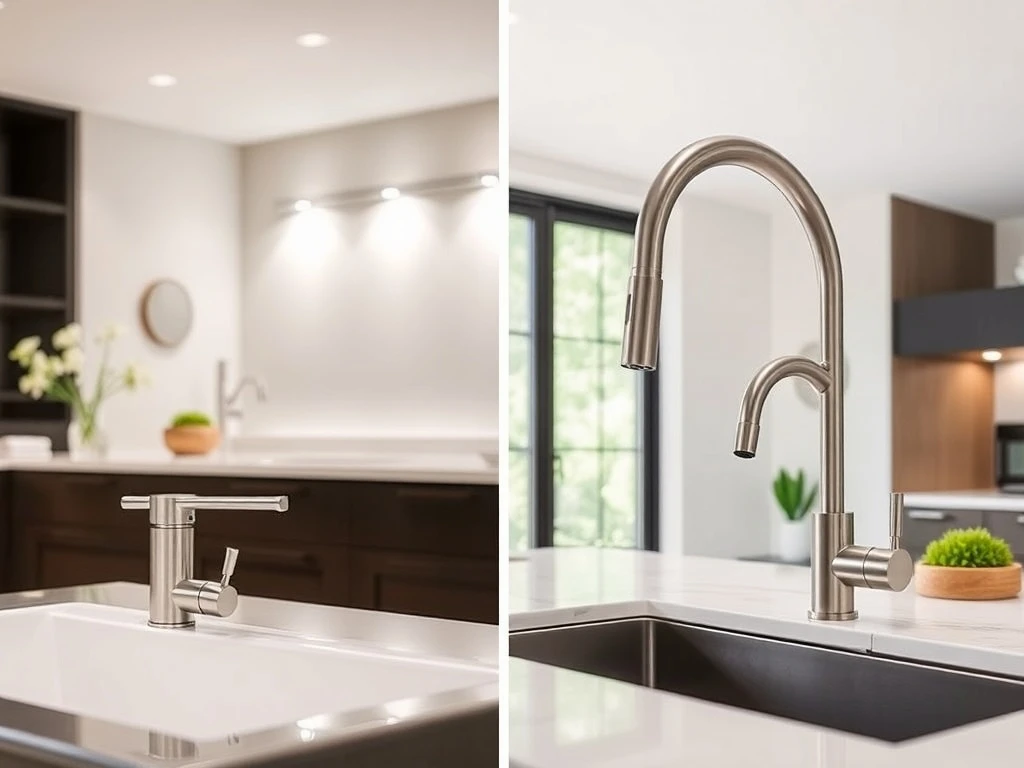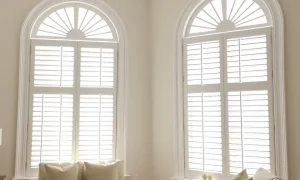When it comes to enhancing your living space, few upgrades offer as much impact as new Bathroom Sink Faucets and Kitchen Faucets. These essential fixtures are more than just water dispensers; they are pivotal elements that define the aesthetic, functionality, and overall value of your home. For homeowners and business-minded individuals alike, understanding the nuances of selecting the right faucets can translate into significant long-term benefits, from improved water efficiency to a striking interior design. Let’s dive into how the perfect blend of style and practicality can truly transform your home.
Why Your Faucets Matter: Beyond Simple Functionality
Faucets are often underestimated, yet they play a crucial role in our daily routines. A leaky, outdated, or inefficient faucet can be a constant source of frustration, leading to increased water bills, potential water damage, and a diminished sense of style. Conversely, investing in high-quality Bathroom Sink Faucets and Kitchen Faucets offers a multitude of advantages:
- Enhanced Aesthetics: Faucets are prominent design elements. Modern, stylish fixtures can instantly update the look of your bathroom or kitchen, acting as focal points that tie the entire design together.
- Improved Water Efficiency: Many contemporary faucets incorporate water-saving technologies like low-flow aerators, which reduce water consumption without compromising performance. This not only benefits the environment but also leads to noticeable savings on your utility bills.
- Superior Hygiene and Convenience: Features like touchless operation, pull-down sprayers, and easy-to-clean finishes contribute to a more hygienic environment and simplify daily tasks.
- Increased Property Value: Updated bathrooms and kitchens are key selling points for any home. High-quality fixtures signal attention to detail and a well-maintained property, potentially boosting resale value.
- Long-Term Durability: Investing in reputable brands and materials like solid brass or stainless steel ensures your faucets will withstand years of daily use, reducing the need for frequent repairs or replacements.
Choosing the Best Bathroom Sink Faucets: A Guide to Elegance and Efficiency
Your bathroom is a sanctuary, and the right Bathroom Sink Faucets can elevate it from merely functional to truly luxurious. When selecting these crucial fixtures, consider both the visual appeal and the practical benefits they offer. Here’s what to look for:
Style and Finish: Making a Statement
The aesthetic of your bathroom faucet should complement your overall design theme. Popular finishes include:
- Matte Black: A bold, contemporary choice that adds a dramatic contrast.
- Brushed Nickel: Versatile and timeless, offering a soft, muted look that resists fingerprints.
- Polished Chrome: Classic, highly reflective, and easy to clean, fitting a wide range of styles.
- Brass/Gold Tones: Ranging from vintage to modern, these add warmth and a touch of opulence.
Beyond finish, consider the faucet’s configuration:
- Single-Handle Faucets: Offer a minimalist look and easy temperature and flow control with one hand. Ideal for smaller sinks or a sleek, uncluttered vanity.
- Double-Handle (Widespread or Centerset) Faucets: Provide precise temperature control and a more traditional or grand appearance. Widespread faucets have separate hot and cold handles, while centerset options combine them on a single base plate.
- Wall-Mount Faucets: A modern, space-saving option that frees up counter space, often seen in high-end designs. Requires specific plumbing during installation.
Functionality and Durability: What to Prioritize
Beyond looks, the internal workings of your Bathroom Sink Faucets are paramount:
- Water-Saving Technology: Look for faucets with the WaterSense label, indicating they meet EPA criteria for water efficiency (using at least 20% less water than standard models). Low-flow aerators are key.
- Ceramic Disc Cartridges: These are the gold standard for durability and drip-free performance. Unlike rubber washers, ceramic discs are highly resistant to wear and tear.
- Flow Rate (GPM): For bathrooms, a flow rate of 1.2 to 1.5 gallons per minute (GPM) is common for WaterSense certified models, offering ample pressure for handwashing and brushing teeth.
- Ease of Installation: Many modern faucets come with quick-connect systems, making DIY installation feasible for the handy homeowner. However, professional installation is always an option for complex setups.
Kitchen Faucets: Where Culinary Innovation Meets Everyday Convenience
The kitchen is truly the heart of the home, and its faucet is arguably the most used fixture. Today’s Kitchen Faucets are engineered with cutting-edge features to simplify everything from meal prep to cleanup. Choosing the right one can dramatically improve your kitchen workflow.
Essential Features for the Modern Kitchen
Modern kitchen faucets offer an array of features designed for convenience and efficiency:
- Pull-Down and Pull-Out Sprayers: These are indispensable for multitasking. Pull-down sprayers extend directly down into the sink, while pull-out sprayers offer more reach. Both are perfect for rinsing produce, cleaning large pots, and reaching all corners of the sink.
- Touchless Operation: A game-changer for hygiene, especially when hands are messy. Simply wave your hand or an object near the sensor to activate water flow.
- 360-Degree Swivel Spouts: Offers maximum flexibility, particularly useful for double-bowl sinks or filling pots on the counter next to the sink.
- High-Arc Spouts: Provide ample clearance for filling tall pots and large containers, a practical choice for busy kitchens.
- Integrated Water Filters: Some advanced models include built-in filtration systems, providing clean, filtered water directly from the tap.
Design Trends in Kitchen Faucets
Kitchen faucet designs are as varied as kitchen styles themselves:
- Industrial-Style: Often featuring exposed springs and robust construction, these faucets add a professional, chef-inspired look.
- Farmhouse: Characterized by classic, often bridge-style designs and finishes like bronze or antique brass, complementing rustic or traditional kitchens.
- Contemporary Minimalism: Sleek lines, simple forms, and often chrome or stainless steel finishes, perfect for modern, uncluttered spaces.
Matching your kitchen faucet to your cabinetry, countertops, and backsplash creates a cohesive and polished look. Consider the size of your sink and the overall scale of your kitchen when choosing a faucet to ensure it looks proportionate and functions optimally.
Seamless Style: Matching Bathroom Sink Faucets and Kitchen Faucets
A growing trend in home design is the coordination of fixtures throughout the house. Many homeowners now opt for faucet sets that share a consistent finish or design language across both the bathroom and kitchen. This creates a unified, sophisticated aesthetic that speaks to thoughtful design. Whether you’re drawn to the warmth of vintage brass or the sleekness of futuristic stainless steel, maintaining consistency helps to unify the overall space.
When planning your upgrades, consider not just individual pieces but how they contribute to the whole. For example, if your home features brushed nickel hardware on doors and cabinets, extending that finish to your Bathroom Sink Faucets and Kitchen Faucets can create a harmonious flow. Many manufacturers offer collections that span various fixture types, making it easier to achieve this coordinated look.
Sustainability and Smart Living: The Future of Faucets
As environmental consciousness becomes a core value for many, faucet manufacturers are responding with innovative solutions. Products meeting WaterSense or other environmental standards are becoming increasingly common. These faucets are designed to use significantly less water—up to 30% less than traditional models—without compromising performance. This makes them a responsible choice for both the planet and your wallet, reducing your water footprint and utility bills.
Beyond water efficiency, smart faucet technology is rapidly evolving. Imagine voice-activated controls that dispense precise measurements of water, programmable water temperature settings for your morning routine, or LED indicators that change color to show water temperature, preventing accidental scalding. These premium features, while an investment, offer unparalleled convenience, safety, and a glimpse into the smart home of the future.
Making Your Choice: Actionable Insights
With so many options, selecting the right Bathroom Sink Faucets and Kitchen Faucets can seem daunting. Here are some actionable tips to guide your decision:
- Set a Budget: Faucets range widely in price. Determine what you’re willing to spend, keeping in mind that higher-quality materials and advanced features often come with a higher price tag but also greater durability.
- Consider Your Lifestyle: Are you a busy cook who needs a powerful sprayer? Do you prioritize hygiene with touchless features? Your daily habits should influence your choice.
- Match Your Existing Decor: While a complete overhaul is an option, often the best choice is a faucet that complements your current sink, countertop, and cabinet style.
- Read Reviews: Online reviews can provide valuable insights into a faucet’s performance, durability, and ease of installation.
- Check Water Pressure: Ensure your home’s water pressure is compatible with the faucet’s recommended flow rate for optimal performance.
- DIY vs. Professional Installation: Decide if you’re comfortable with a DIY project or if professional installation is preferred. Many modern faucets come with quick-connect systems for easier self-installation.
Conclusion: A Smart Investment for Your Home
Upgrading your home with modern Bathroom Sink Faucets and Kitchen Faucets is a simple yet profoundly impactful way to blend functionality, style, and sustainability. From significantly reducing water waste to enhancing your interior aesthetics and streamlining daily tasks, the right faucet can do it all. Whether you’re embarking on a full-scale remodel or simply replacing outdated fixtures, exploring high-quality options is a smart investment. Your home deserves the best in design, innovation, and efficiency, and the perfect faucets are key to achieving that.
Frequently Asked Questions (FAQs) About Faucets
1. What’s the average lifespan of a good quality faucet?
A good quality faucet, especially one with ceramic disc cartridges, can last anywhere from 15 to 20 years or even longer with proper maintenance. Cheaper models might only last 5-10 years.
2. Are touchless faucets worth the extra cost?
Touchless faucets offer significant benefits in terms of hygiene, convenience (especially with messy hands), and often water saving. While they typically cost more upfront, many users find the benefits outweigh the added expense, especially in high-traffic kitchens.
3. How do I choose the right finish for my faucets?
Consider your existing hardware and decor. Polished chrome is classic and versatile. Brushed nickel offers a muted, contemporary look. Matte black provides a bold statement. Brass or gold tones add warmth and elegance. It’s often best to match the finish with other fixtures in the room for a cohesive design.
4. What does “WaterSense certified” mean for faucets?
WaterSense is a program sponsored by the U.S. Environmental Protection Agency (EPA). A WaterSense certified faucet meets EPA’s criteria for water efficiency and performance, using at least 20% less water than conventional faucets while still providing adequate water flow and pressure.
5. Can I install a new faucet myself, or should I hire a professional?
Many modern faucets are designed for relatively easy DIY installation, especially if you’re replacing a similar type of faucet. They often come with quick-connect systems and clear instructions. However, if you’re unfamiliar with plumbing, changing faucet types (e.g., from deck-mount to wall-mount), or encounter unexpected issues, hiring a professional plumber is recommended to avoid leaks and ensure proper installation.
6. What’s the difference between pull-down and pull-out kitchen faucets?
A pull-down faucet’s spray head pulls directly down into the sink from the spout, often with a high-arc design. A pull-out faucet’s spray head pulls straight out from the spout, offering more reach around the sink area and sometimes even beyond the sink. The choice depends on personal preference and sink configuration.
























